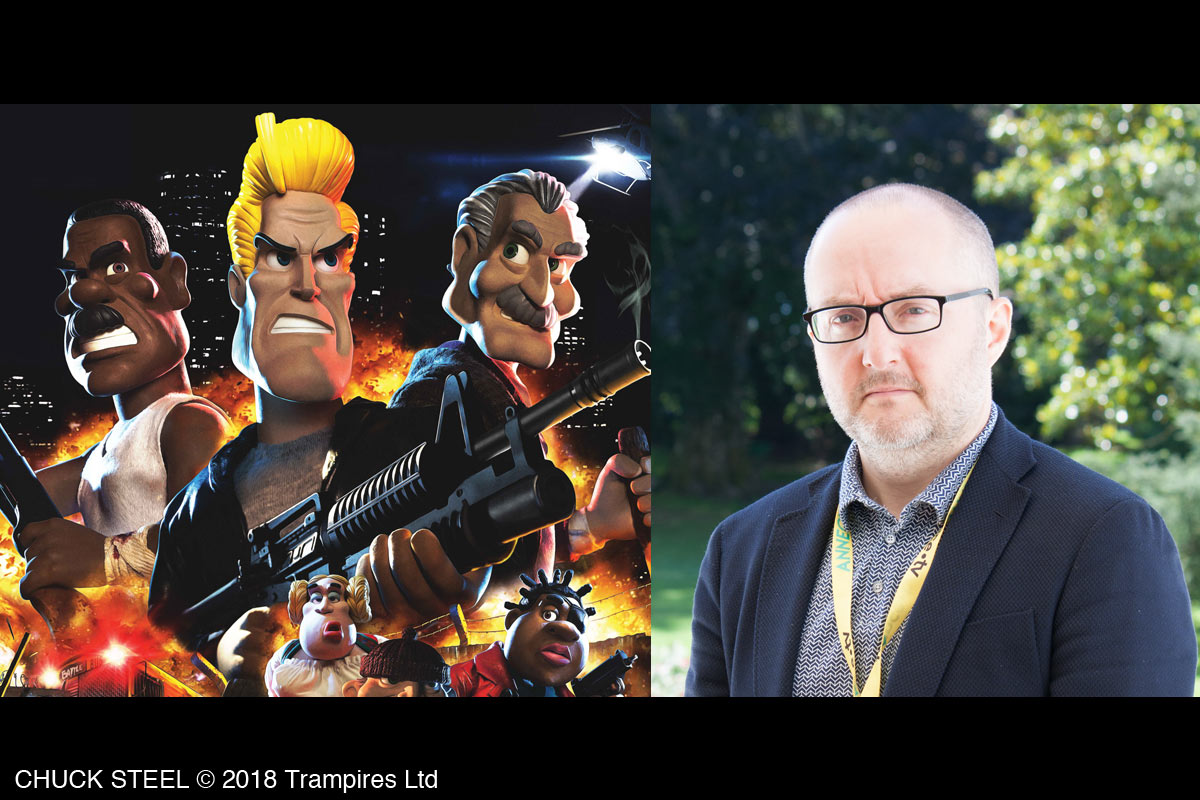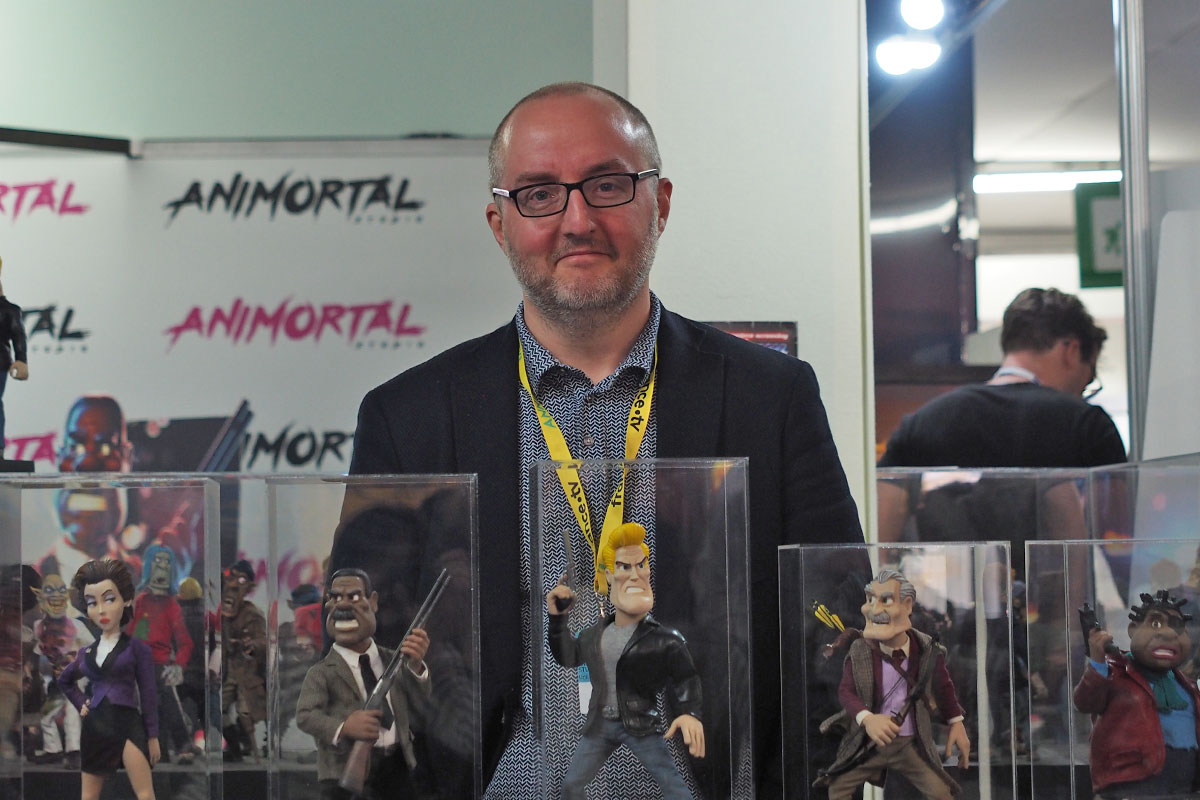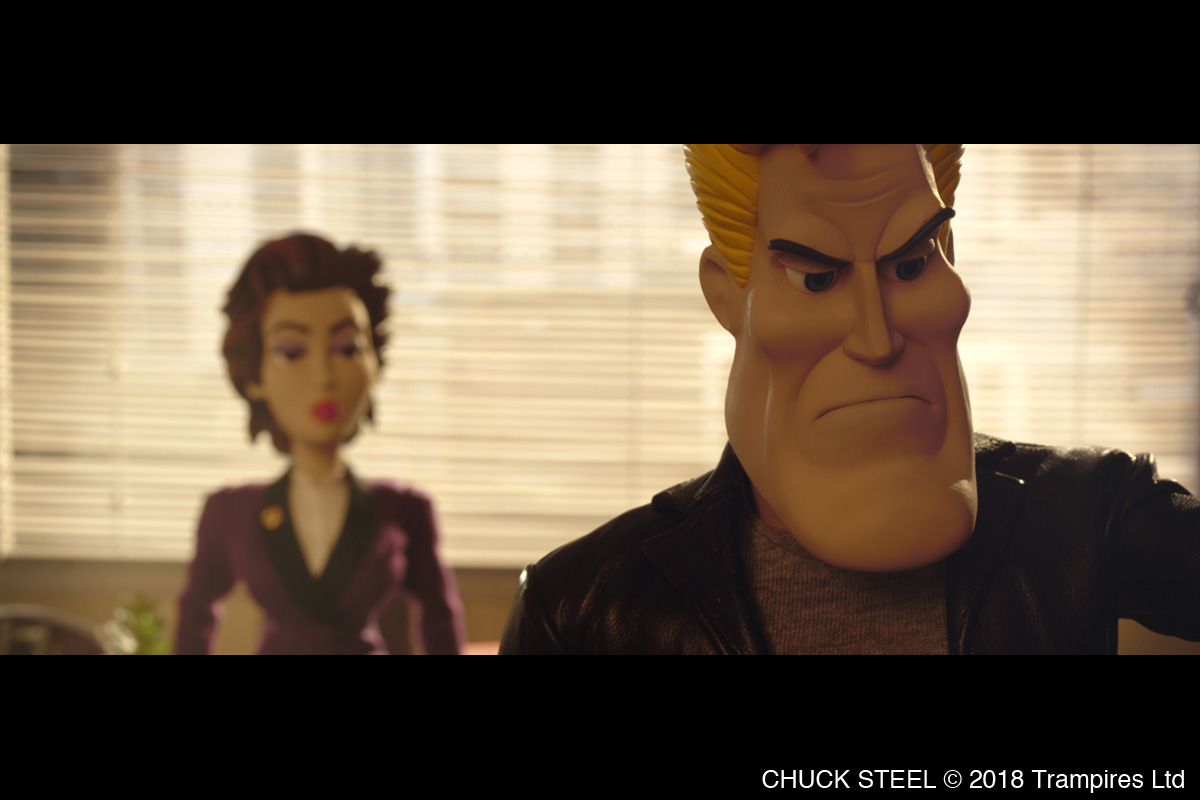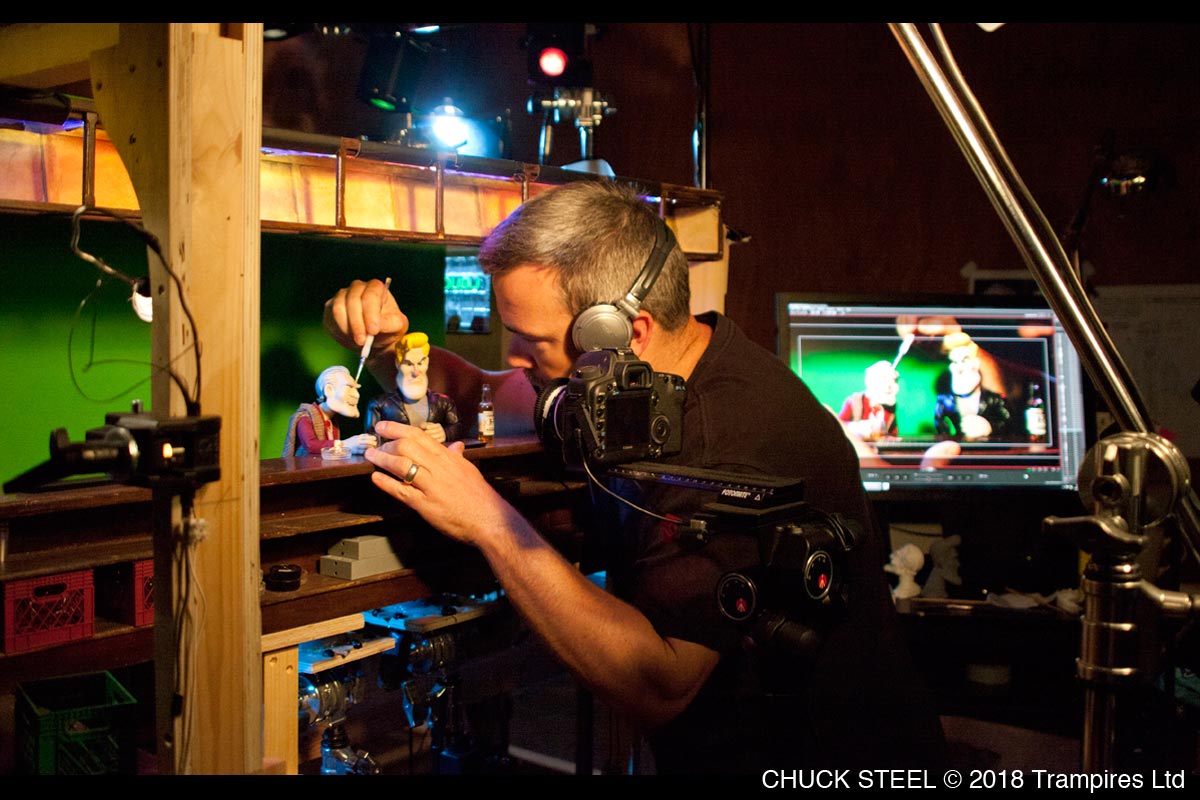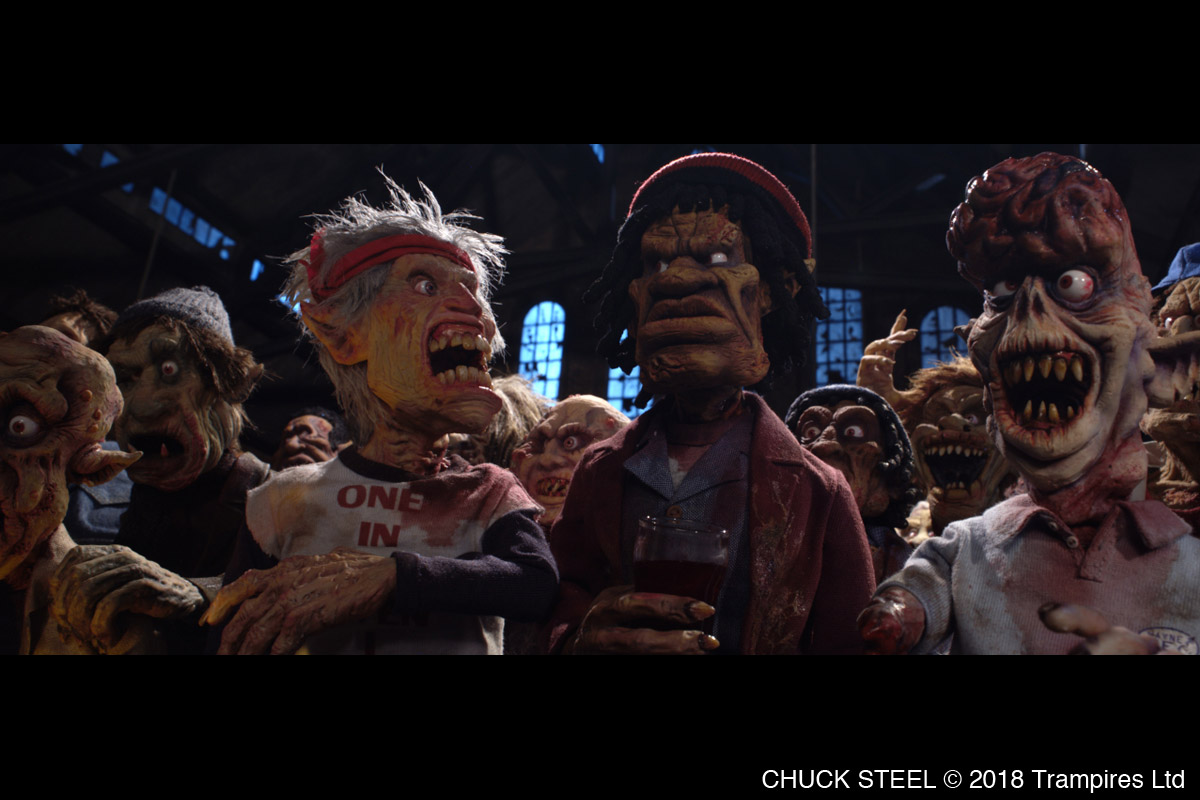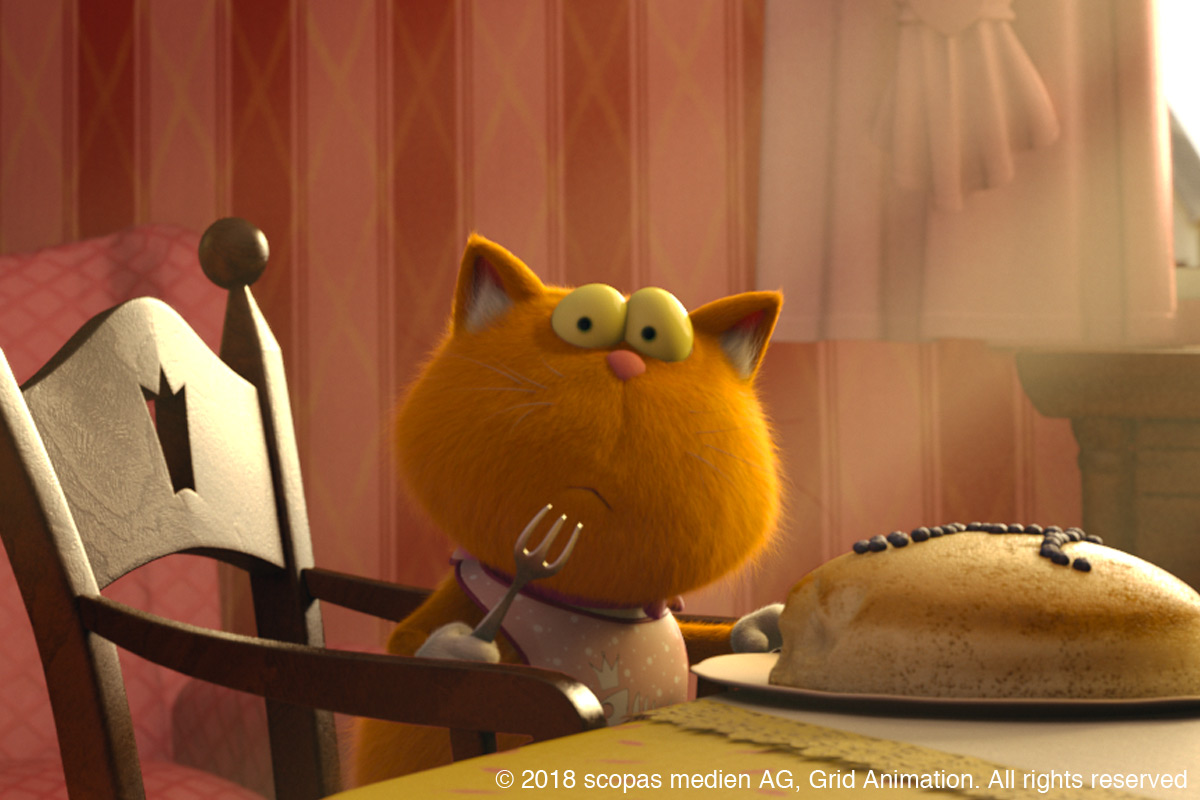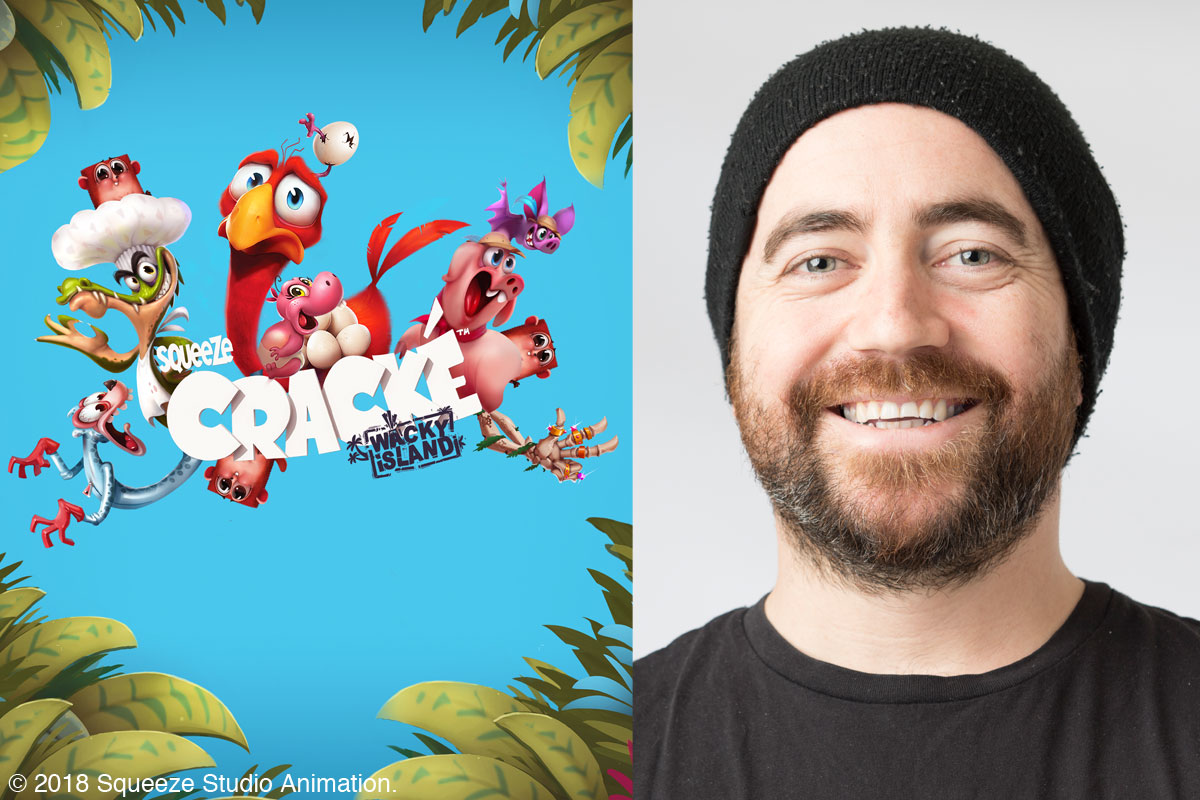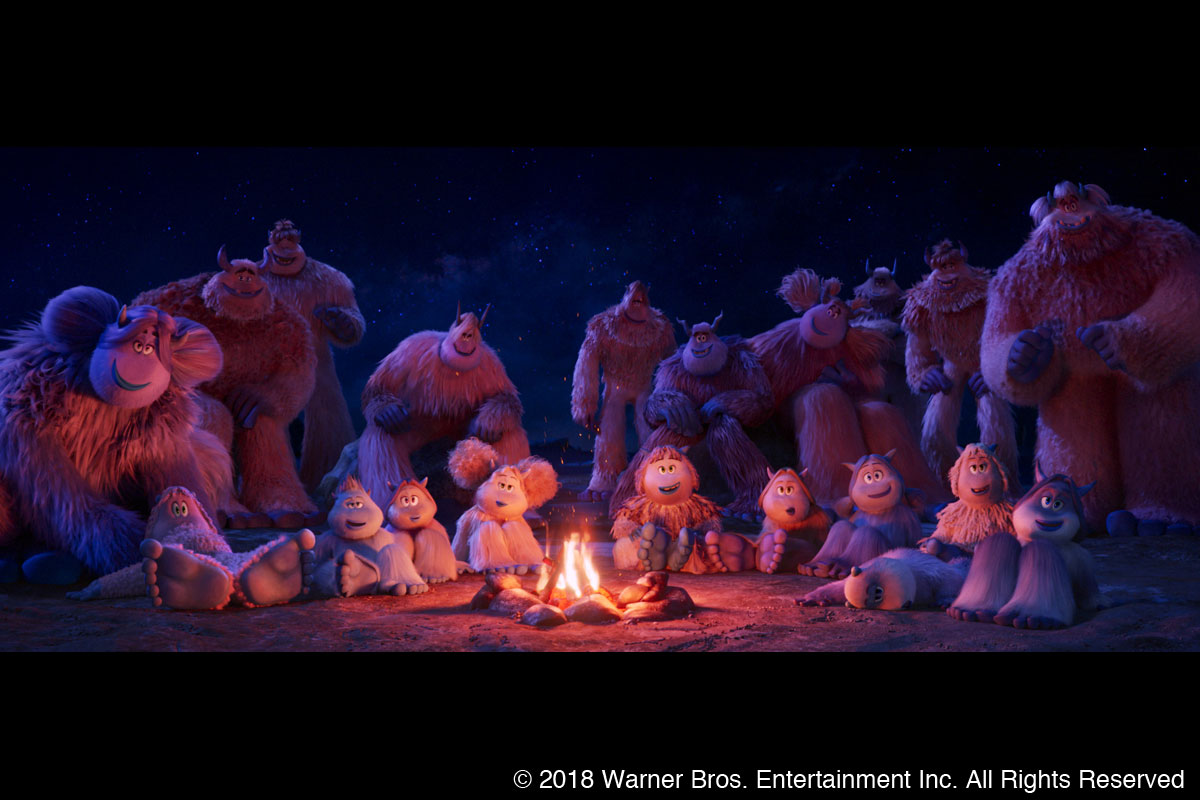Synopsis
It’s 1986, and Chuck Steel is ‘the best God damn cop on the force’ according to his boss, Captain Jack Schitt. But even this maverick, renegade, loose cannon, lone wolf, cop on the edge who doesn’t play by the rules has his work cut out for him when the Governor of LA decides to reduce the licensing hours for clubs and bars, triggering a sudden, inexplicable spate of high profile assaults in the city. The attacks all have one thing in common, a crime scene covered in blood but with no sign of the victim. When the latest victim manages to survive an attack, Chuck visits her in hospital and is confronted by a crazed old man who introduces himself as Abraham Van Rental. He warns a disbelieving Chuck that an evil scourge is about to descend on the city of Los Angeles – the scourge of the TRAMPIRES – a mutated hybrid of vampire and tramp…
Chuck Steel: Night of the Trampires is a stop-motion action-horror-comedy animated feature filled to the brim with epic stop-motion action sequences, inspired by and paying great homage to the great action movies of the 80’s.
Around close to midnight on 12th June, the world premiere of Animortal Studio’s debut feature was held in Annecy, France, as a part of Annecy International Animated Film Festival 2018.
After the world premiere, I could hear the story behind the film and the development process from the director of the film Mike Mort. I’m excited to share his words with you.
Interview with Mike Mort
Trayton Scott: Where did the initial idea of the story come from?
Mike Mort: I came up the character Chuck Steel when I was 15 years old whilst still in school. I used to doodle him when I should’ve been listening in class. Around that time, I used to make Super-8 short films with the character. When I went to college, I made more short films. When I got into the industry as an animator and director, I’ve always been trying to make a film with that character. I wrote the feature script in 2001, and I was in Annecy 15 years ago trying to get this film made. I wasn’t getting any luck, because adult animation is quite hard to get funded, since people are still a little nervous about it. It didn’t go anywhere for a number of years, and I parked it on a shelf.
Then around 2012, I was just frustrated with the fact that I wasn’t getting anywhere with my ideas, and I just felt the need to make another Chuck Steel short film, so I decided to make another short film in my basement. I wrote a 15-minute short film script, which was based on the idea of trying to make a 3-act feature structure to show what it could be if it were to be expanded. I came up with a scenario and a basic story that worked in that way. I’ve set about making the models, and I made a cast of about 20 characters and also started making the set, because I’ve been a model maker myself. I’ve just been able to do it on my own, so I just thought I’d be there for the next few years making that film.
Then I got introduced to businessmen, who are now my business partners, who have invested in lots of different things, but are also huge animation fans, particularly in a project I did a few years ago called Gogs. They came on-board and helped me complete the funding of the short film. We had a crew of 6 working on that in my basement for the next 18 months. That worked out really well, and as soon as we done that, we started talking about making a feature film, and I already had the script from 2001, ready to go. I did try to talk them out of doing that script, thinking it’s too big, there’s too many characters in it, it’s too hard, but they wanted to do it. I’m glad they did, because we pulled of an epic stop-motion film, I think.
Trayton Scott: I thought this film was such a great spoof of the 80’s action movies. What elements of those movies inspired you for Chuck Steel?
Mike Mort: I grew up in the 80’s, and I loved all those old Chuck Norris, Steve Segal, and Bruce Willis action movies. Cobra was a real influence, it was such a ludicrous action film, but at the time it was released, it was just a straight-up action film. You watch it now, and you would just laugh.
I began re-watching these films when I had the idea for the short film. I would look and notice how they were lit, and they were lit in a way that there is a lot of shadow, with little bits of light in the darkness, and I thought this was actually quite easy to achieve on a small budget. You can create the same atmosphere with minimal actual set builds, and it’s all about the look of the film, the lens flares, the little camera moves, things like that which make it feel authentic, and are easy to achieve now with software.
I researched all those films again and I try to put as much of them into the short film as I could, because when I started the short film, I thought that would be the end of it. I would just do another short film and leave it there, but I got lucky with meeting my business partners, and here we are now with the feature film.
Trayton Scott: What was the most difficult part in your whole journey of making the story?
Mike Mort: For the feature film, the hardest part was the sheer scale of what we were trying to do. I think we got a thousand more shots in this film than any other stop motion film.
We had to make those stylistic choices and have lots and lots of small shots in the film, which is hard to achieve in animation because of the setup time. Lighting it, moving the camera, etc., all adds time to your production shoots. Trying to do this film on a budget that’s a lot smaller than other stop-motion films, whilst trying to add more characters and more shots, was the challenge. We are trying to keep that epic scale whilst being an independent movie, really, and trying to come off like we are a big budget film.
Trayton Scott: I thought the film had such great, memorable characters. What was your process in developing them?
Mike Mort: Like I said, the character Chuck Steel was from when I was 15, so it was 30 years of thinking about a character and how he works. Obviously, when I started the character, he was a bit more simplistic. I started to get into learning about writing and script structure, and character development. It came naturally to me through that type of character, because it was so familiar to me and I liked writing dialogue that is ridiculous as well, especially the scenes with Jack and Chuck talking. It in those scenes, it is almost like you are arguing with yourself, in your head. It just flows, you know?
I wouldn’t say there’s tons of character development, since they are such archetypal, clichéd characters, but I just wanted to make them as ridiculous as possible and push the absurdity of those clichés. At the same time, I wanted to give them a little bit of humanity somehow, just through the way the story develops and how they interact with each other, and how they are friends even though they are constantly shouting at each other.
Trayton Scott: The film was so entertaining with a lot of very funny jokes. During the premier on Tuesday, the audience was just roaring with laughter, so what do you think is the best way of integrating such funny gags and jokes into the script?
Mike Mort: A hard question, because when I tend to write, I do mull over scenes for a while, I get little ideas for moments in the film, either action sequences, or just silly lines and ideas for conversations, and sometimes that comes from real life. I try to keep notes of lines that pop into my head, but it’s an organic process, so sometimes you sit there trying to make that dialogue work and it doesn’t happen. Sometimes, you sit there and it just flows. It’s not something I can really explain.
There are also a lot of references to the 80’s as well, so there are jokes in there that people will recognize, or it’d be nods to other films, but I didn’t want to make it too obviously spoofing a particular film. I wanted it to feel like a film from that era, but not necessarily having specific elements from specific films like Lethal Weapon or Die Hard. I didn’t want to do something too reminiscent, just make it stylistically feel like those films.
Trayton Scott: The film is such a spectacle with so much action and gore. How did you accomplish such a dynamic visual with stop motion animation? What was the most difficult technical challenge?
Mike Mort: The action scenes are actually quite fun to storyboard. I love coming up with action scenes and set pieces. In the storyboarding phase, you have to be as detailed as you can, but there was a little bit of freedom on the set to, for example add a little cutaway of an explosion or a bullet, because of the pace of the edit we wanted to make. Because this is an animation, you do have to try to plan that as much as possible, so there was a long storyboarding phase.
The way we created that dynamic live-action feel is to keep the camera moving all the time, so even if we don’t use a motion-control rig for the shot, we do hand-held wobbling in post-production, and we add things like lens flare, dust and dirt, things like that, just to bring it away from stop motion and more into the live-action arena.
The storyboarding phase is a fun phase, but you are meant to go into it without any limits. You just do what you think is going to work, and figure out the problems later.
Actually, one of the hardest things in the film are the dialogue scenes. The puppets had basically a solid skull with a Plasticine skin, and you have to take the head off, sculpt the lips in, and put the head back on, for every frame. I only did it this way because it’s the way I know how, and that’s a really long way of doing it. Nobody else does it like that anymore, because it’s stupid (laughs).
But we did it because stylistically we didn’t want it to look like replacement mouths and replacement heads, because we didn’t have the budget to do the ultra-slick facial replacements like in Laika Entertainment. That requires such a long period of pre-production and rapid prototyping and all of that. We just didn’t have access to that, so the work ended up being done in the shot by the animator.
It was the one thing that slowed down the production down a lot, and it was hard for people to sometimes do. It’s a particular skill. In hindsight, we will try and find a quicker way of doing that next time.
The actual fighting and action scenes… They are no more challenging than most other stop-motion shots. In fact, there is a benefit to them because they are short. A long stop-motion shot can go wrong in the middle, and you have to go back and fix it. With an action shot, it can sometimes be 12 frames long, and you can get through that quite quickly. You know in the edit that you are going to shake the camera a bit and add motion-blur in post-production, so sometimes the flaws in the animation disappear. With that, you can be slightly more forgiving when you’re approving a shot.
You can be ultra-fussy about stop-motion, but it was none of that with some of the short action sequences. As long as the shot had the right vibe, and I knew it was going to work, we would usually go through with it on the first take.
Trayton Scott: There were a lot of impressively gory scenes of characters with melting skin all the way to the bone. How was that achieved in stop-motion?
Mike Mort: For the melting scenes, most of our human characters we stylistically needed to have Plasticine faces on them, so they would have that life to them. For the villains, as soon as they became a creature or a trampire, we went to a latex skin, which was painted with acrylics for it to look like the 80’s style of prosthetics and monster effects from that era. And that was a stylistic choice.
When it came down to the melting scenes, we would have the trampire puppet or the creature be latex for most shots. As soon as we got to a shot where it needed to melt, it would be replaced by a version that was basically a skeleton, with a skin on top of it that was made from meltable red wax that is painted with acrylics quite thickly, and that would yet create another layer of skin.
For each frame you are trying to animate this character, you would put a heat gun or a hairdryer onto it and it would slightly melt. You would take the frame as it’s melting, and then take the heat away so it wouldn’t melt too quickly. It was quite hard to judge whether it’s too much, and whether to take it away. The painted skin would actually sag and look like skin, revealing the red melted blood underneath. Once that fell off, it revealed the skeleton sculpt that was there, so it was like a three-layered thing.
As you can see in the film, a lot of those melting shots are quite quick, because you can only control that stuff so far, because it is actually melting frame-by-frame. But there’s no CGI with it. We did add smoke coming off and blood spraying coming out of eyes in post-production, but the whole thing was a stop-motion meltdown.
Trayton Scott: There was an impressive variety of trampire characters. We would like some insights on the pipeline of designing, fabricating, and rigging a puppet.
Mike Mort: The creature and character designs I did myself during the pre-production. One of my favorite things to do is character designs, so I can just sit down with a pen and come up with a hundred trampires, a hundred tramps, two hundred crowds, and so on. That was during the pre-production phase, and I really enjoyed that.
Then that goes to our construction team, or our puppet team. If our character were human, they would be sculpted with Plasticine, and if they were trampires, they would be with latex. Each one was with a ball-and-socket armature. We didn’t use any wire armatures because we knew they were going to break, so we had to find a reasonable way of doing full armatures for 425 puppets, which is a lot to get through.
We built 5 or 6 body shapes, from tall to short, fat to thin, females and males, and they were cast in a foam material, All the heads were different, but the bodies were variations of these shapes. The hands were interchangeable pieces of silicone that could come out. The shoes were latex slip-on skin things, which were durable. A lot of times, when you use foam latex or silicone, they can tear, but liquid latex is quite durable, so they would last the entire shoot, usually. Whenever we can use liquid latex, we did.
The costumes were handmade after the foam bodies were made.
Trayton Scott: What was it like working with Joris de Man on the score?
Mike Mort: I met Joris on a short film, because I played a game called Killzone 2, and I heard the music thinking “Wow, this is really great music for a game”, and I looked at the credits and made a note of his name. I looked him up, and it turned out that he is married to an animation producer I worked with years ago, and he is based in the UK, so I rang him for the short film.
He did such a good job with just digital instruments that sounds like a real orchestra, and I think he is a genius for getting such an authentic 80’s score. Luckily on this film, we were able to record it with an actual philharmonic orchestra in Prague, so Joris has been key to this film feeling like a genuine 80’s film.
I really hope he gets to do more films on the back of this, because he’s such a good composer, and we will be definitely be working together on the next one.


